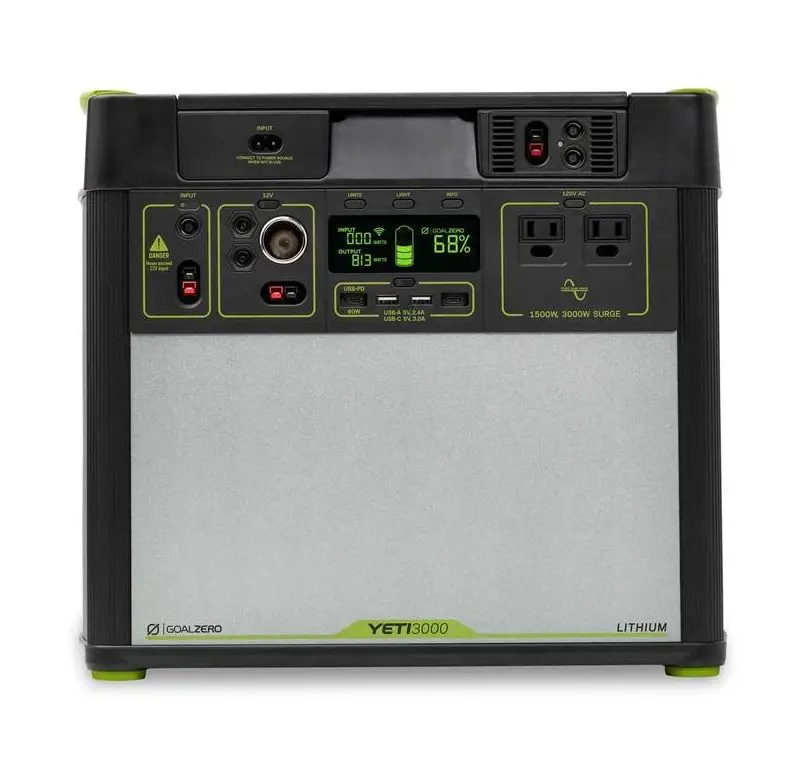Goal Zero has made several iterations of solar generators throughout the years, and this comparison post is going to highlight the differences between similar models that use lithium-ion batteries.
Below you’ll find the four comparisons I’ll be guiding you through.
| Power stations compared | Winner | What makes it better? | Check price |
|---|---|---|---|
| Yeti 3000 Lithium vs. Yeti 3000X | Yeti 3000X | 1. Superior output ports 2. Faster recharging | Amazon |
| Yeti 1400 Lithium vs. Yeti 3000 Lithium | Yeti 3000 Lithium | 1. Has MPPT charge controller (Yeti 1400 doesn’t) 2. Bigger battery (lasts longer) | Not available |
| Yeti 1400 Lithium vs. Yeti 1500X | Yeti 1500X | 1. Better output ports 2. Faster recharging speeds | Amazon |
| Yeti 1400 Lithium vs. Yeti 1000 Lithium | Yeti 1400 Lithium | 1. Similar weight even with a larger battery 2. Pairs with Yeti app (Yeti 1000 doesn’t) | Not available |
Table of contents
Goal Zero Yeti 3000 Lithium vs Yeti 3000X (Ports, Features, & More)
The Goal Zero Yeti 3000X is a better option compared to the Yeti 3000 Lithium because of the following features:
- Better output and input ports (regulated plus more power)
- Faster recharging speeds (from the wall and from solar panels)
Both the Yeti 3000X and the Yeti 3000 Lithium have the same battery type (Li-ion NMC) and cycle life. The 3000X, however, has a more powerful inverter.
There’s much more to unpack for these two solar generators.
Depending on your specific needs, one may suit you more than the other.
Main Specs: Yeti 3000 Lithium vs. Yeti 3000X
| Specs | Yeti 3000 Lithium | Yeti 3000X |
|---|---|---|
| Max AC Output | 1,500W (3,000W surge) | 2,000W (3,500W surge) |
| Output Ports | 2x USB-A 1x USB-C 1x USB-C PD 2x 6mm (12V) 1x 12V car port 1x High Power Port 2x AC outputs | 2x USB-A 1x USB-C 1x USB-C PD 2x 6mm (12V) 1x 12V car port 1x High Power Port 2x AC outputs |
| Max Solar Input | 500W | 600W |
| Battery Type | Li-ion NMC | Li-ion NMC |
| Battery Capacity | 3,075Wh | 3,032Wh |
| Battery Lifecycles | 500 cycles to 80% capacity | 500 cycles to 80% capacity |
| Weight | 68.6 lbs | 69.78 lbs |
| Dimensions | 10.1 x 15.3 x 13.1 in | 10.23 x 15.25 x 13.6 in |
| WiFi Enabled? | Yes | Yes |
| Availability | Discontinued | In stock |
| Product Manual | Yeti 3000 manual | Yeti 3000X manual |
Estimated Charging Times – Yeti 3000 vs. 3000X
| Solar Array | Solar Output @ 80% Efficiency | Est. Charging Time (0-100%) Yeti 3000 Lithium | Est. Charging Time (0-100%) Yeti 3000X |
|---|---|---|---|
| 500W | 400W | 9-10 hrs @ 400W | 9-10 hrs @ 400W |
| 700W | 560W | 7-8 hrs @ 500W | 7-8 hrs @ 500W |
| 800W | 640W | 7-8 hrs @ 500W | 6-7 hrs @ 600W |
Since the 3000X can take in up to 600W of solar input, you can charge the power station in as little as six hours with the appropriate amount of panels (600-1,200W) and good weather conditions.
If you are charging your solar generator from the wall, it’ll take 14 hours when using the 230W AC wall charger that comes with it. However, there is a 600W AC wall charger sold separately that will charge it in six hours.
Using the Yeti 3000 Lithium’s maximum solar input (500W), you can charge it in about 7-8 hours.
In the “Q&A” section of the 3000 Lithium on Goal Zero’s website, their support staff answered the question on how to properly set up the Yeti 3000 Lithium to receive maximum solar intake. See the picture below for the answer.
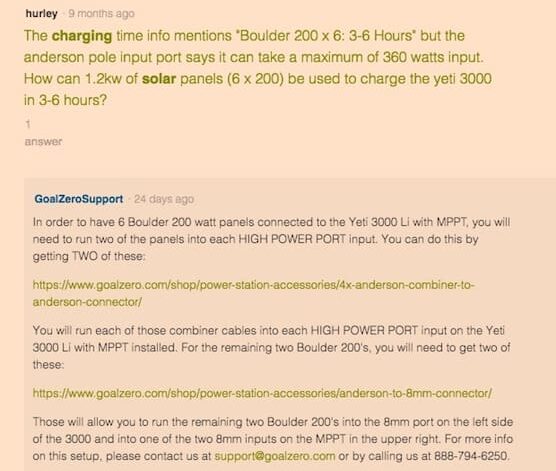
For AC charging with its two included wall chargers, the 3000 Lithium model will take about 25 hours to charge up. This is almost twice as long as the 3000X.
However, it takes a maximum of 10 hours to recharge the 3000 Lithium when using the Yeti Fast Charge 25 Amp Power Supply (not included).
Interestingly, both solar generators can be charged when using the Goal Zero Yeti Lithium 12V Car Charging Cable. However, the manufacturer didn’t specify the generators’ charge times when using their car charging cable.
Verdict – Recharging Times
It takes about the same amount of time for the two solar generators to charge up when the solar input is 500W or less. However, with the Yeti 3000X’s 600W max input, it can recharge about one hour faster than the 3000 Lithium.
With no additional AC charging attachments, the Yeti 3000X beats the 3000 by a whopping 11 hours.
Even with upgrades like the 600W AC charger for the 3000X and the 25A power supply for the 3000 Lithium, the 3000X still beats the 3000 Lithium by four hours of charge time (6 hours total).
Input & Output Port Variations

As you’ll see below, the port options are the same, however, the abilities of each port vary significantly between the two power stations.
The only ports that are the same are the USB-A and USB-C PD ports.
| Input/Output Ports | Port Specs: Yeti 3000 Lithium | Port Specs: Yeti 3000X |
|---|---|---|
| 2x USB-A | 12W max (regulated) | 12W max (regulated) |
| 1x USB-C | 15W max (regulated) | 18W max (regulated) |
| 1x USB-C PD | 60W max (regulated) | 60W max (regulated) |
| 2x 6mm ports | 120W max | 120W max (regulated) |
| 1x 12V car port | 120W max | 160W max (regulated) |
| 1x 12V power pole port | 240W max | 360W max (regulated) |
| 2x AC outputs | 1,500W (3,000W surge) | 2,000W (3,500W surge) |
| 1x 8mm charging port (input) | 14–22V, up to 10A (120W max) | 14-50V, up to 10A (150W max) |
| 1x Power pole charging port (input) | 14–22V, up to 30A (360W max) | 14-50V, up to 50A (600W max) |
Weight and Portability
These 3,000Wh Yeti generators are very heavy and are mainly meant to stay in one place for a long time. That being said, both power stations come with a roll cart to make it easier to maneuver if needed.
The Yeti 3000X weighs in at 69.7 pounds. The Yeti 3000 Lithium has an overall weight of 68.6 pounds.
Both solar generators are heavy compared to many others in the solar industry.
However, it’s unsurprising due to their large battery capacity specifications.
As for size, both of these models have similar dimensions.
The 3000X is 0.5 inches wider than its predecessor, which is the largest difference between the two:
- Yeti 3000 Lithium: 10.1 x 15.3 x 13.1 in
- Yeti 3000X: 10.23 x 15.25 x 13.6 in
Similar: The Best Lightweight Solar Generators | Pure Power Solar
Battery Type
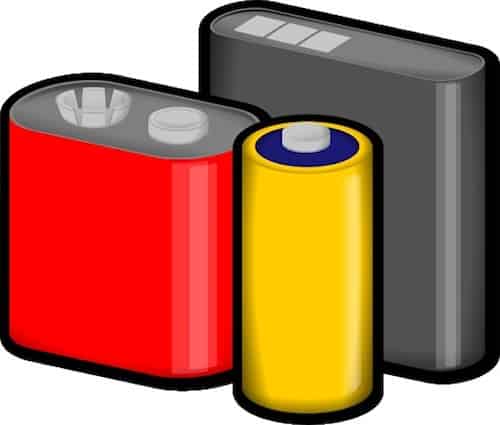
The “battery type” category describes the kind, or more specifically, the cell chemistry of the solar generator’s battery.
Most solar generators today use the lithium-ion battery, while some still use the heavier lead-acid battery.
The only battery type that can compete with lithium-ion or lithium NMC batteries is the lithium-iron-phosphate (LiFePO4) battery. Aside from those two battery types, others are less common in the industry.
The Yeti 3000X uses a lithium-ion NMC battery. These batteries are lighter in weight than lead-acid, and they also have high energy densities.
A high energy density makes the solar generator more reliable for charging and powering several types of appliances.
Verdict: Both solar generators use the same kind of battery (Li-ion NMC). So, users can enjoy high energy densities in both power stations.
Also, you can enjoy the lightweight feature of the generator compared to those who use lead-acid batteries. For example, the Yeti 1250 has a lead-acid battery and weighs about 30 pounds more than the Yeti 3000!
Battery Expandability
Expandability means the ability to scale up the battery capacity.
Some solar generators (usually large ones) produce expandable batteries connectable to the solar generators to provide a higher battery storage capacity.
One of the common solar generators known to have this feature is the Titan.
Both the Yeti 3000 and Yeti 3000 Lithium are expandable solar generators.
They feature battery chaining technology that permits users to link extra batteries with ease.
Using Goal Zero’s Yeti Tank lead-acid expansion battery, a single Tank will add 1,200Wh of energy storage to the solar generator.
This feature enables the generator to charge and power devices and appliances for much longer.
WiFi Connectivity
Both the 3000X and 3000 Lithium can be operated via the Yeti app.
Users can sync the device directly with the Yeti app by using Direct Connect or through an available Wi-Fi network.
Individuals can monitor the battery level, power in and out, and operate ports with ease. Since both of the solar generators have this feature, it’s a win-win situation.
Conclusion
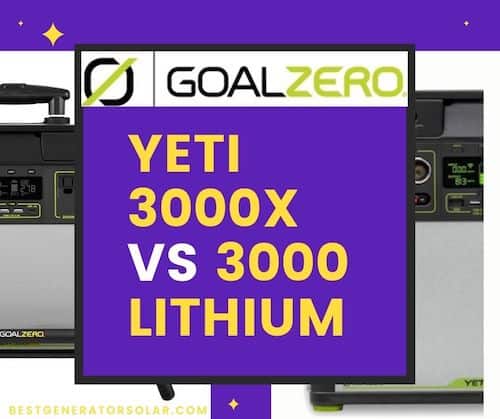
Overall, the Yeti 3000X is better than the Yeti 3000 Lithium due to its regulated 12V outputs, increased input power, and increased output power from multiple different ports.
Although this may not be a surprise since the 3000X is the successor to the 3000 Lithium, comparing these models shows Goal Zero’s progress with second-generation solar generators.
Goal Zero Yeti 1400 Lithium vs. Yeti 3000 Lithium
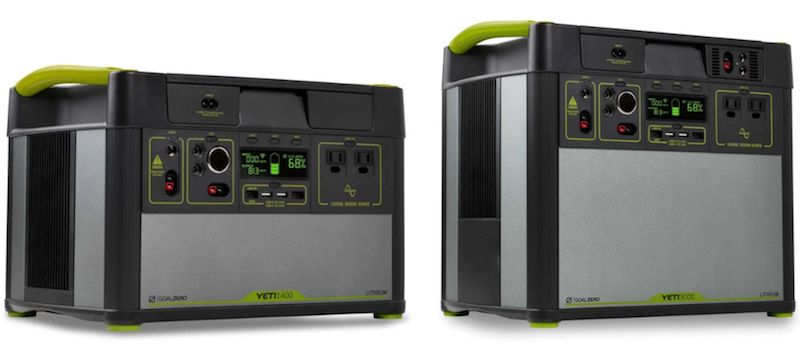
Overall, the Yeti 1400 and Yeti 3000 have a lot of similarities, but their major differences are their battery capacities and charge controllers.
The Yeti 3000 has an MPPT charge controller, allowing for faster solar charging. The Yeti 1400 MPPT is sold separately.
The Yeti 3000’s battery capacity is over twice the capacity of the 1400, making it the ideal solar generator for home backup.
Main Specs: Yeti 1400 Lithium vs. Yeti 3000 Lithium
Several features are shared between both systems, most of which have to do with the output port options.
| Specs | Yeti 1400 Lithium | Yeti 3000 Lithium |
|---|---|---|
| Max AC Output | 1,500W (3,000W surge) | 1,500W (3,000W surge) |
| Output Ports | 2x USB-A 1x USB-C 1x USB-C PD 2x 6mm (12V) 1x 12V car port 1x High Power Port 2x AC outputs | 2x USB-A 1x USB-C 1x USB-C PD 2x 6mm (12V) 1x 12V car port 1x High Power Port 2x AC outputs |
| Max Solar Input | 360W | 500W |
| Battery Type | Li-ion NMC | Li-ion NMC |
| Battery Capacity | 1,425Wh | 3,075Wh |
| Battery Lifecycles | 500 cycles to 80% capacity | 500 cycles to 80% capacity |
| Weight | 43.7 lbs | 68.6 lbs |
| Dimensions | 10.1 x 15.3 x 10.4 in | 10.1 x 15.3 x 13.1 in (Yeti only) |
| WiFi Enabled? | Yes | Yes |
| Availability | Discontinued | Discontinued |
| Product Manual | Yeti 1400 manual | Yeti 3000 manual |
Charging Times
Solar generators are often able to charge up in different ways. For instance, you can charge your solar generators by plugging them directly into a wall socket or by using solar panels.
With its single 5A wall charger, the Yeti 1400 charges up in about 25 hours.
However, by using the maximum solar input of 360W, you can charge it up in around five hours.
As for the Yeti 3000 Lithium, using its two included 5A wall chargers, it also takes about 25 hours to charge fully.
With around 500W of maximum solar input, the 3000 Lithium can recharge in a similar timeframe as the Yeti 1400.
Overall, both generators take quite a while to charge, however, the Yeti 3000 requires a higher amount of power to recharge in the same time period as the Yeti 1400.
Goal Zero Solar Panel Combinations
Examples of Goal Zero solar panels are the:
- Boulder 100
- Boulder 100 Briefcase
- Nomad 100
- Boulder 200 Briefcase
You can combine these solar panels to charge your generator.
What is the charge time of these generators after getting combined? Let’s see the possible combinations.
| Goal Zero Solar Panel Combinations | Est. Charging Times w/ Yeti 1400 Lithium |
|---|---|
| Nomad/Boulder 100 x 3 | 6-12 hours |
| Nomad/Boulder 200 x 2 | 5-10 hours |
| Nomad/Boulder 200 x 3 | 4-8 hours |
| Nomad/Boulder 200 x 4 | 3-6 hours |
| Goal Zero Solar Panel Combinations | Est. Charging Times w/ Yeti 3000 Lithium |
|---|---|
| Boulder 100 x 3 | 12-24 hours |
| Nomad/Boulder 200 x 2 | 9-18 hours |
| Nomad/Boulder 200 x 3 | 6-12 hours |
| Nomad/Boulder 200 x 4 | 4-8 hours |
| Nomad/Boulder 200 x 6 | 3-6 hours |
With a battery over twice the size of the Yeti 1400, the Yeti 3000 requires more energy to charge up from solar panels.
The larger generator also features a pre-installed solar charging optimization module, which functions as an MPPT (Maximum Power Point Tracker) that helps increase the charging percentage by 40%. Mostly, this increment applies to solar panels.
The only downside to this is the cost of solar panels. In other words, it’s not so pocket-friendly to buy six Boulder 200s.
Similar: Top 15 Best Solar Generators for Camping (Small to Large)
Ports
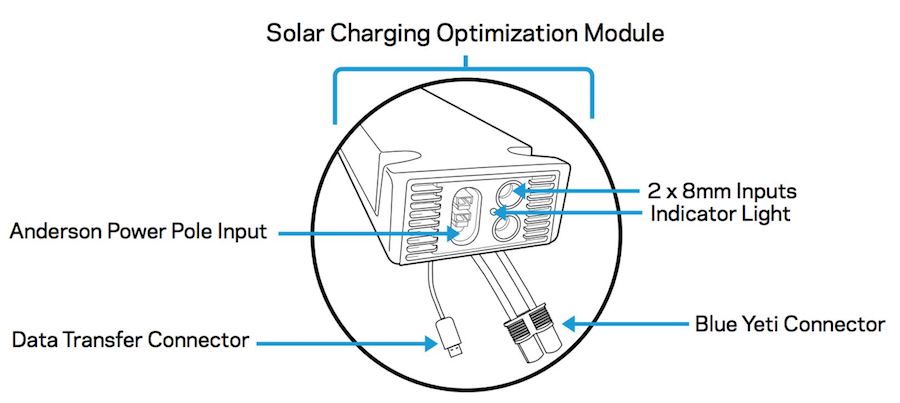
Overall, there’s almost no difference between the Yeti 1400 ports and those of the Yeti 3000. The only difference is that the Yeti 3000 has an MPPT charge controller in addition to its PWM controller.
The PWM is shared with the Yeti 1400, while the MPPT is unique to the larger model.
This additional piece of equipment allows for faster charging.
| Input/Output Ports | Port Specs |
|---|---|
| 2x USB-A | 12W max (regulated) |
| 1x USB-C | 15W max (regulated) |
| 1x USB-C PD | 60W max (regulated) |
| 2x 6mm ports | 120W max |
| 1x 12V car port | 120W max |
| 1x 12V power pole port | 240W max |
| 2x AC outputs | 1,500W (3,000W surge) |
| 1x 8mm charging port (input) | 14–22V, up to 10A (120W max) |
| 1x Power pole charging port (input) | 14–22V, up to 30A (360W max) |
Size
The Yeti 3000 and 1400 Lithium share the same length and width, but the 3000 Lithium is a few inches taller.
The Yeti 1400 measures 10.1 x 15.3 x 10.4 inches, while the Yeti 3000 stands at 10.1 x 15.3 x 13.1 inches (without its roll cart).
Even with similar dimensions, the weight difference between the two is 24.9 pounds. The Yeti 1400 weighs approximately 43.7 pounds, while the Yeti 3000 weighs about 68.6 pounds.
What Can They Power?
Below, I’ve listed some example devices and appliances that each generator can power below.
I also added how long each would power those devices, using “hours” for non-rechargeable appliances (e.g., fridges) and “recharges” for the number of times a device can be recharged (e.g., smartphones, laptops, cameras, etc.).
| Device/Appliance | Ports Used | Yeti 1400 Lithium | Yeti 3000 Lithium |
|---|---|---|---|
| Smartphone (10Wh) | USB-A/USB-C | 114 recharges | 246 recharges |
| Laptop (60Wh) | USB-C PD | 19 recharges | 41 recharges |
| Full-Size 120V Fridge (70W) | AC | 13.2 hours | 28.5 hours |
| 55″ LED TV (80W) | AC | 11.5 hours | 25 hours |
| Space Heater (1,000W) | AC | 55 minutes | 2 hours |
As seen above, the Yeti 3000 outlasts the Yeti 1400 by approximately twice its capability.
Additional Highlights
- Easy to Use: Goal Zero power stations tend to have simple designs/layouts to make them easy to operate. This is a similar attribute to Jackery’s power stations.
- Port Flexibility: With seven different output ports (ten total) on each model, you can use these power stations with most devices.
- WiFi Connectivity: Both the Yeti 1400 and 3000 favor WiFi connectivity, which pairs your solar generator to your phone or tablet via the Yeti app. With the mobile app, you can turn ports on and off, check battery levels, and update the Yeti’s firmware with a chosen device.
Final Verdict
In conclusion, without a doubt, these generators are both efficient, so choosing between these two will require personal taste and budget.
For instance, if the price is a problem, the Yeti 1400 may be the best choice. However, the Yeti 3000 can be used for longer periods off the grid due to its larger battery.
Although the Yeti 3000 is bulkier and more expensive than the Yeti 1400, it’s the ideal choice for extended backup power.
Both systems are heavy and they have the same output ports. The Yeti 3000 also has an MPPT charge controller that doubles its recharging speed compared to its PWM controller.
Unfortunately, both of these models are no longer sold by Goal Zero. However, they released new versions of both – the Yeti 1500X (see comparison below) and Yeti 3000X.
Goal Zero Yeti 1400 vs. 1500X (Predecessor vs. Successor)
The Yeti 1500X is the direct successor to the Yeti 1400 Lithium. By keeping the high-quality aspects of the older 1400 model and upgrading key components, the better option between the two power stations is the Yeti 1500X.
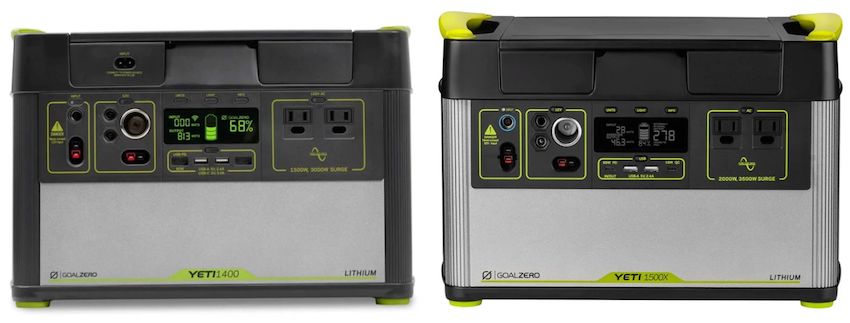
Main Specs: Yeti 1400 Lithium vs. Yeti 1500X
A couple of key metrics to look for here include solar input power as well as AC output.
| Specs | Yeti 1400 Lithium | Yeti 1500X |
|---|---|---|
| Max AC Output | 1,500W (3,000W surge) | 2,000W (3,500W surge) |
| Output Ports | 2x USB-A 1x USB-C 1x USB-C PD 2x 6mm (12V) 1x 12V car port 1x High Power Port 2x AC outputs | 2x USB-A 1x USB-C 1x USB-C PD 2x 6mm (12V) 1x 12V car port 1x High Power Port 2x AC outputs |
| Max Solar Input | 360W | 600W |
| Battery Type | Li-ion NMC | Li-ion NMC |
| Battery Capacity | 1,425Wh | 1,516Wh |
| Battery Lifecycles | 500 cycles to 80% capacity | 500 cycles to 80% capacity |
| Weight | 43.7 lbs | 45.64 lbs |
| Dimensions | 10.1 x 15.3 x 10.4 in | 15.25 x 10.23 x 10.37 in |
| WiFi Enabled? | Yes | Yes |
| Availability | Discontinued | In stock |
| Product Manual | Yeti 1400 manual | Yeti 1500X manual |
Estimated Charging Times – Yeti 1400 Lithium
| Solar Array | Solar Output @ 80% Efficiency | Est. Power Loss (PWM) | Est. Charging Time (0-100%) |
|---|---|---|---|
| 300W | 240W | 20% | 9-10 hrs @ 192W |
| 400W | 320W | 20% | 6.5-8 hrs @ 256W |
| 500W | 400W | 20% | 5.5-7 hrs @ 320W |
| 600W | 480W | 20% | 5-6 hrs @ 360W |
Estimated Charging Times – Yeti 1500X
| Solar Array | Solar Output @ 80% Efficiency | Est. Power Loss (MPPT) | Est. Charging Time (0-100%) |
|---|---|---|---|
| 300W | 240W | 0% | 8-9 hrs @ 240W |
| 400W | 320W | 0% | 6-7 hrs @ 320W |
| 500W | 400W | 0% | 4.8-6 hrs @ 400W |
| 600W | 480W | 0% | 4.2-5.5 hrs @ 480W |
| 800W | 640W | 0% | 3-4 hrs @ 600W |
Using the AC wall charger, you’ll need to wait 25 hours to get a fully-charged power station.
Most importantly, the Yeti 1400 uses PWM charging technology, which is usually secondary to MPPT charging in terms of performance.
As the Yeti 1500X has a 600W MPPT charge controller, its charging time is much faster and more efficient than that of the Yeti 1400 power station.
This improvement in solar input capability brings a much faster charge to the 1500X when using its maximum solar input.
The duration for AC/wall charging depends on the capacity of the wall charger. A wall charger rated 120W charges the solar power station for 14 hours while a charger rated 230W charges for seven hours.
Overall, both power stations use the same charging methods, but the Yeti 1500X, although having a larger battery capacity than the 1400, charges at a faster rate because of its MPPT charge controller and up to 600W of input power.
The Yeti 1400 Lithium charges slower than the Yeti 1500X due to its PWM charge controller and 360W (maximum) solar input.
Input & Output Port Differences
Although both power stations have the same type of input/output ports, there are several differences to each port’s capabilities.
| Input/Output Ports | Port Specs: Yeti 1400 Lithium | Port Specs: Yeti 1500X |
|---|---|---|
| 2x USB-A | 12W max (regulated) | 12W max (regulated) |
| 1x USB-C | 15W max (regulated) | 18W max (regulated) |
| 1x USB-C PD | 60W max (regulated) | 60W max (regulated) |
| 2x 6mm ports | 120W max | 120W max (regulated) |
| 1x 12V car port | 120W max | 160W max (regulated) |
| 1x 12V power pole port | 240W max | 360W max (regulated) |
| 2x AC outputs | 1,500W (3,000W surge) | 2,000W (3,500W surge) |
| 1x 8mm charging port (input) | 14–22V, up to 10A (120W max) | 14-50V, up to 10A (150W max) |
| 1x Power pole charging port (input) | 14–22V, up to 30A (360W max) | 14-50V, up to 50A (600W max) |
The Yeti 1500X has more powerful AC ports, 12V ports, and charging ports than the Yeti 1400 Lithium. Plus, the 1500X’s 12V outputs are regulated, which is convenient for powering sensitive devices.
Size and Portability
The Yeti 1400 weighs about 44 lbs. While that is a sizable weight, it can still be carried short distances with two people grabbing a handle on each side of the power station.
Its two handle straps rest atop the power station.
As stated by its manufacturer, the weight of the Yeti 1500X is 45.64 lbs.
Similar to the Yeti 1400, the power station comes with handles for some maneuverability.
You can also buy a roll cart (pictured to the right) for the 1500X if you want to be able to travel with it often.
Verdict
The weight difference between the two power stations is almost negligible, as they measure out at nearly the same weight.
Plus, their dimensions are also nearly identical.
Durability and Warranty
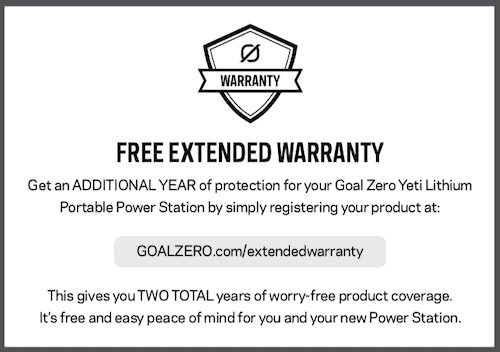
When discussing power stations’ durability, a vital point to consider is the cycle life of the generator’s battery.
A single lifecycle occurs when you use up the majority of your battery before recharging.
The Yeti 1400 is rated for 500 cycles before its battery capacity reaches about 80% of its original capacity, which implies that the battery can last for well over a year if the battery is used from full capacity to zero every day.
Comparatively, the Yeti 1500X shares the same battery cycle life rating of 500 cycles to 80% capacity.
Another point that we should consider is the warranty period given on the products. And, as with the lifecycles, both products have the same warranty period of 24 months.
Verdict: Both power stations are equally durable if battery longevity and an extended warranty period are important to you.
Conclusion

Although the Yeti 1400 and 1500X may look the same on the outside, with their similar design and port options, the 1500X is a beefed-up version of the Yeti 1400.
Out of the total input and output ports on these models, they only share the same USB-C PD port and USB-A ports. Every other port has different characteristics, with the vast majority of them being more powerful in the Yeti 1500X.
Check out my video analysis comparing the two below.
Goal Zero Yeti 1400 vs. Yeti 1000 (Aesthetics & Internals)
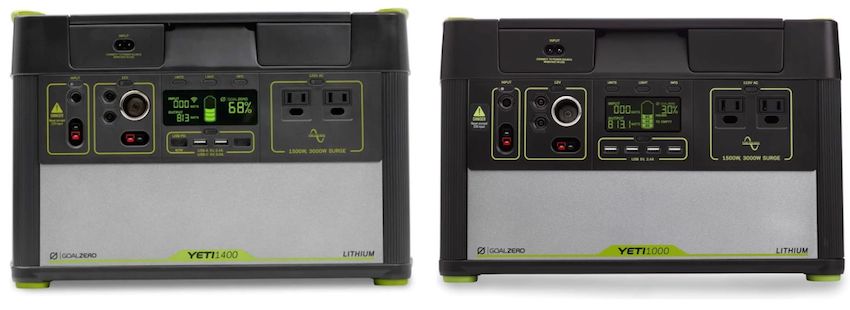
With a bigger battery, WiFi connectivity, and more output port options, the Yeti 1400 Lithium is the winner over the Yeti 1000. Although the 1400 Lithium takes longer to charge, its battery will last longer while off the grid.
Main Specs: Yeti 1400 Lithium vs. Yeti 1000 Lithium
| Specs | Yeti 1400 Lithium | Yeti 1000 Lithium |
|---|---|---|
| Max AC Output | 1,500W (3,000W surge) | 1,500W (3,000W surge) |
| Output Ports | 2x USB-A 1x USB-C 1x USB-C PD 2x 6mm (12V) 1x 12V car port 1x High Power Port 2x AC outputs | 4x USB-A 2x 6mm (12V) 1x 12V car port 1x High Power Port 2x AC outputs |
| Max Solar Input | 360W | 360W |
| Battery Type | Li-ion NMC | Li-ion NMC |
| Battery Capacity | 1,425Wh | 1,045Wh |
| Battery Lifecycles | 500 cycles to 80% capacity | 500 cycles to 80% capacity |
| Weight | 43.7 lbs | 40 lbs |
| Dimensions | 10.1 x 15.3 x 10.4 in | 10.1 x 15.3 x 9.3 in |
| WiFi Enabled? | Yes | No |
| Availability | Discontinued | Discontinued |
| Product Manual | Yeti 1400 manual | Yeti 1000 manual |
These two solar generators look nearly identical when lined up next to each other, but the differences between the Yeti 1000 and 1400 Lithium can’t be seen entirely with the naked eye.
It’s the internal functionality that sets them both apart.
For example, the Yeti 1400 has about 400Wh of additional battery capacity compared to the Yeti 1000, yet it weighs only three pounds more.
Plus, the 1400 Lithium can pair with your mobile device to control its capabilities over WiFi. The Yeti 1000 does not have this unique feature.
Solar Charging Times – Yeti 1400 vs. Yeti 1000
| Solar Array | Solar Output @ 80% Efficiency | Est. Power Loss (PWM) | Est. Charging Time (0-100%) Yeti 1400 Lithium | Est. Charging Time (0-100%) Yeti 1000 Lithium |
|---|---|---|---|---|
| 300W | 240W | 20% | 9-10 hrs @ 192W | 7-8 hrs @ 192W |
| 400W | 320W | 20% | 6.5-8 hrs @ 256W | 5-6.5 hrs @ 256W |
| 500W | 400W | 20% | 5.5-7 hrs @ 320W | 4.5-6 hrs @ 320W |
| 600W | 480W | 20% | 5-6 hrs @ 360W | 4-5 hrs @ 360W |
A 5A power supply is included with both systems for wall charging. It takes 18 hours to fully recharge the Yeti 1000, while the Yeti 1400 takes 25 hours for a full charge.
The Yeti 1000 clearly charges faster than Yeti 1400 power station. This is true for both wall charging and solar charging.
They both have the same wall chargers and maximum solar input, and since the Yeti 1400 has a battery that’s 400Wh larger, it takes longer to recharge.
Similar: 3 Stages of Camping Solar Panels from Goal Zero
Input & Output Ports
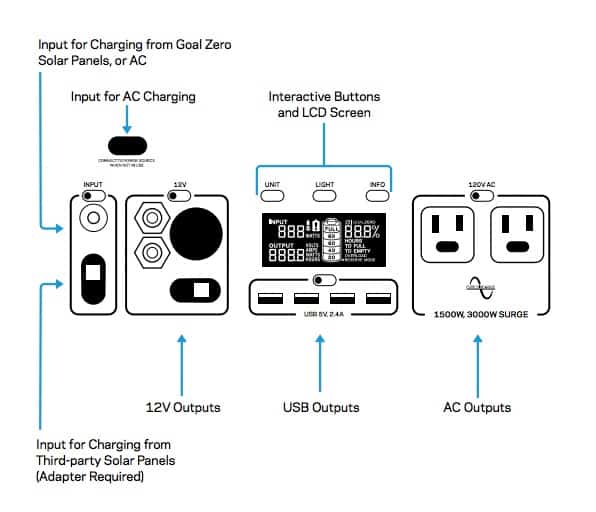
| Input/Output Ports | # | Port Specs: Yeti 1400 Lithium | # | Port Specs: Yeti 1000 Lithium |
|---|---|---|---|---|
| USB-A | 2 | 12W max (regulated) | 4 | 12W max (regulated) |
| USB-C | 1 | 15W max (regulated) | 0 | N/A |
| USB-C PD | 1 | 60W max (regulated) | 0 | N/A |
| 6mm ports | 2 | 120W max | 2 | 120W max |
| 12V car port | 1 | 120W max | 1 | 120W max |
| 12V power pole port | 1 | 240W max | 1 | 120W max |
| AC outputs | 2 | 1,500W (3,000W surge) | 2 | 1,500W (3,000W surge) |
| 8mm charging port (input) | 1 | 14–22V, up to 10A (120W max) | 1 | 14–22V, up to 10A (120W max) |
| Power pole charging port (input) | 1 | 14–22V, up to 30A (360W max) | 1 | 14–22V, up to 30A (360W max) |
The Yeti 1400 power station has three different types of USB ports (Type A, Type C, and PD). Comparatively, the USB options on the Yeti 1000 only include type-A-styled USB ports.
Additionally, the 12V power pole output on the Yeti 1400 is twice as powerful as the Yeti 1000’s (240W vs. 120W).
The rest of the ports in the Yeti 1000 are as powerful as that of the Yeti 1400 power station.
WiFi and App Control – Yeti 1400
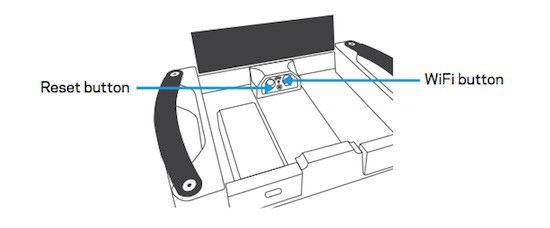
This feature enables users of the Yeti 1400 to connect with their product and control it remotely without having to touch the power station.
This is useful in the home as you can control the power station from any room in the house using the app, and also outdoors from a safe distance.
Some of the operations you can carry out on the app includes powering the power station, activating, and deactivating selected ports for use, controlling and monitoring the charging process, and much more.
The absence of this feature in the Yeti 1000 power station is a big setback when compared to the Yeti 1400.
Conclusion of Goal Zero’s Large Solar Generator Matchups
Overall, Goal Zero’s newest portable power stations have better overall characteristics than previous iterations.
- The Yeti 3000X is the better option over the Yeti 3000 Lithium.
- The Yeti 1500X is easily the best option compared to the Yeti 1400 Lithium.
However, when comparing similar power stations from the same era, the winners had just a few characteristics that set them atop their competition.
The Yeti 3000 Lithium is better than the Yeti 1400 Lithium mainly due to its much larger battery.
However, the 3000 Lithium also has a pre-installed MPPT charge controller that allows it to charge as fast as its smaller counterpart even though it has a battery capacity that’s over twice its size.
When matching up the Yeti 1400 with the Yeti 1000, the 1400 Lithium won due to its larger battery capacity, similar weight, and upgraded USB ports. But the main attribute putting the Yeti 1400 on top is its WiFi capabilities.
Sources
- Goal Zero | Goal Zero’s user guide library: https://www.goalzero.com/pages/user-guides
- LENSUN Solar Energy | Realistic solar panel output expectations versus rated output: https://www.lensunsolar.com/blog/the-solar-panels-output-in-the-real-world/
- Battery University | How to prolong lithium batteries: https://batteryuniversity.com/article/bu-808-how-to-prolong-lithium-based-batteries
- Point Zero Energy | Components of solar generators: https://www.pointzeroenergy.com/5-components-you-shouldnt-overlook-when-buying-a-solar-generator/

